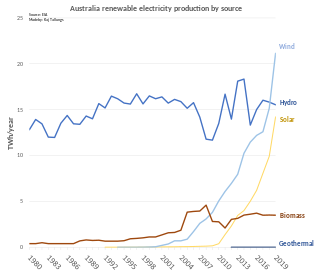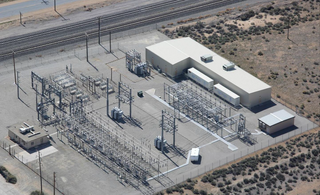The Lakeland Solar Project is a solar farm at Lakeland in Far North Queensland, Australia. The 23 hectare site is positioned off the Mulligan Highway. The project combines big battery storage with big solar. [1] It consists of 41,440 solar panels. [1] Construction began in October 2016.
The solar farm uses islanding to supply power to Lakeland without connecting to the wider grid. [1] The power station can generate 13 megawatts (MW) of power. [2] The battery is rated at 1.4 MW/5.32 MWh. [2]

Lakeland is a rural town and locality in the Shire of Cook, Queensland, Australia. In the 2016 census, the locality of Lakeland had a population of 299 people.

Solar power is a fast-growing industry in Australia. As of June 2023, Australia's over 3.52 million solar PV installations had a combined capacity of 32,095 MW photovoltaic (PV) solar power, of which at least 4,389 MW were installed in the preceding 12 months. In 2019, 59 solar PV projects with a combined capacity of 2,881 MW were either under construction, constructed or due to start construction having reached financial closure. Solar accounted for 12.4% of Australia's total electrical energy production in 2021.

Renewable energy in Australia includes wind power, hydroelectricity, solar photovoltaics, heat pumps, geothermal, wave and solar thermal energy.

Lake Bonney Wind Farm is a wind farm near Millicent, South Australia, Australia. The wind farm is south of, and contiguous with, Canunda Wind Farm. Both are built along the Woakwine Range - a line of stabilised sand dunes that once were coastal.

CS Energy is an Australia-based electricity generating company fully owned by the Government of Queensland with its head office located in Fortitude Valley, Brisbane. The company was established in 1997 and employs more than 500 staff. Adam Aspinall is the Board Chair and Darren Busine is the Chief Executive Officer.

Solar power has been growing rapidly in the U.S. state of California because of high insolation, community support, declining solar costs, and a renewable portfolio standard which requires that 60% of California's electricity come from renewable resources by 2030, with 100% by 2045. Much of this is expected to come from solar power via photovoltaic facilities or concentrated solar power facilities.

The energy sector in Hawaii has rapidly adopted solar power due to the high costs of electricity, and good solar resources, and has one of the highest per capita rates of solar power in the United States. Hawaii's imported energy costs, mostly for imported petroleum and coal, are three to four times higher than the mainland, so Hawaii has motivation to become one of the highest users of solar energy. Hawaii was the first state in the United States to reach grid parity for photovoltaics. Its tropical location provides abundant ambient energy.
South Australia is a leader in utility-scale renewable energy generation, and also produces gas and uranium for electricity generation. Gas production is mostly concentrated in the Cooper Basin in the state's north-east. Gas is delivered from these fields by pipeline to users interstate and to Port Adelaide where it fuels three separate gas-fired power plants. Uranium is also mined in South Australia, though nuclear power generation is prohibited nationally. The Olympic Dam mine is the world's single largest known deposit of uranium and represents 30% of the world's total uranium resource. Many utility-scale wind farms and solar farms have been commissioned during the 21st century and geology with potential for geothermal energy has also been identified but is yet to be developed.
Doolgunna or Doolgunna Station is a pastoral lease and sheep station located in the Mid West region of Western Australia.

The Australian electricity sector has been historically dominated by coal-fired power stations, but renewables are forming a rapidly growing fraction of supply.

A battery storage power station is a type of energy storage power station that uses a group of batteries to store electrical energy. Battery storage is the fastest responding dispatchable source of power on electric grids, and it is used to stabilise those grids, as battery storage can transition from standby to full power in under a second to deal with grid contingencies.
Kennedy Energy Park is a wind, solar and storage hybrid power station approximately 20 km south east of Hughenden and 290 km southwest of Townsville in Queensland.
Neoen is a French producer of exclusively renewable energy headquartered in Paris, France. Founded in 2008, it develops, finances, builds and operates solar power plants, wind farms and energy storage solutions. As at 30 June 2023, the company's total capacity was 7 GW, made up of 47% solar, 34% wind and 19% battery storage. Neoen aims to attain 10 GW in operation or under construction by 2025.
Riverland Solar Storage was a proposed photo-voltaic solar power station planned to be built near Morgan in South Australia.
Gannawarra Solar Farm is a photovoltaic solar power station in the Gannawarra Shire, 13 kilometres (8.1 mi) west of Kerang in the Australian state of Victoria. It generates up to 60 MWdc electricity and exports up to 50.61 MWAC to the National Electricity Market at 66 kV.
The Tesla Megapack is a large-scale rechargeable lithium-ion battery stationary energy storage product, intended for use at battery storage power stations, manufactured by Tesla Energy, the energy subsidiary of Tesla, Inc.
Kidston Solar Project is a photovoltaic solar power station built on top of the former Kidston Gold Mine utilising the tailings storage facility in northern Queensland, Australia. The project consists of two solar farms, KS1 and KS2. The Kidston Solar Project is the first of four projects that comprise the Kidston Clean Energy Hub also occupying this area. A 250 megawatt (MW) hydro-pumped storage power generation project and a 150 MW wind farm make up the third and forth components. The site is located close to an existing substation and transmission line.
Shell Energy Australia provides gas, electricity, environmental products and energy productivity services to commercial and industrial customers.
15°52′07″S144°51′43″E / 15.86861°S 144.86194°E